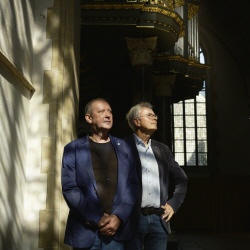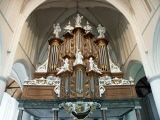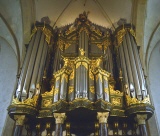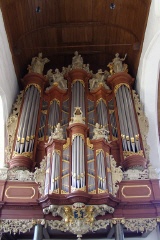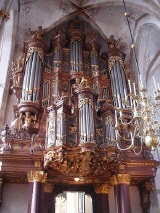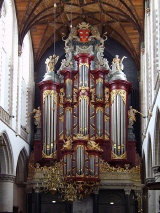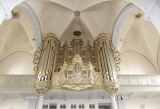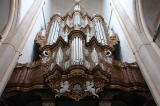Bach Cantatas Project
In 2006 is een start gemaakt met de cd serie 'Bach Cantatas'; opnames van cantatedelen van J.S. Bach, gearrangeerd door Sybolt de Jong voor orgel vierhandig. Het project wordt gedragen door een team van vier mensen. Naast de twee organisten zijn dat opnametechnicus Jack Westra (WestraMedia) en technisch / muzikaal adviseur en regisseur Jelle Stellingwerf.
Inmiddels zijn de volgende delen verschenen:
The project ‘J. S. Bach, Cantata movements for organ four hands’ makes very clearly defined demands on the recording and editing team: allow the organs to sound such that the voice-leading so characteristic for this music remains audible and, therefore, able to be followed by the listener. The extent to which very considerable compromises had to be made in terms of the sound of the organs themselves was very limited, although an important detail nevertheless. Why was this the case?
Each combination of church and organ, produces an ‘optimum’: a three-dimensionally determined place where two microphones in an A-B formation suffice to create a recording which does justice both to the organ and to the listener. Listening back to the recording using a pair of normal living room speakers, the listener feels as if he is experiencing a live organ concert in the church in question. Nothing new about this, of course. The ‘optimum’ was easily found in the Grote Kerk in Leeuwaarden (CD II in the series); the church in question is a fairly long, narrow, and not especially high room in which the beautiful Müller organ is somewhat compactly installed. With the microphone stand in the correct position and at the correct height, and with two additional, and slightly more separated microphones to slightly accentuate the breadth in the mix, a very realistic recording became possible which, on the one hand, completely fulfils the previously mentioned demand for sufficient transparency and, on the other, places the listener ‘actively’ in the pew, experiencing the concert first-hand as it were.
The recording in the St.-Petrikirche in Melle, Germany (CD V in de series) is also a good example of this relatively simple principle. In other words: the simpler the set-up, the more honest the recording sounds. This is and will remain our point of departure.
Unfortunately, things are not always so simple. The Bovenkerk in Kampen (CD III) and the St.-Bavo in Haarlem (CD VI) are both enormous, high rooms with large organs located high above the floor. Without a doubt both beautiful and monumental, but in both cases the optimum seems so high and far away from the organ that the required transparency is difficult to obtain, although no less desirable. Although fine for normal organ repertoire, these Bach transcriptions with, for example, an ever-present continuo line, become almost literally a bridge too far. The ‘optimum’ sounds less than optimal; somewhat dull, less transparent and with less presence than desired. Although still clearly the organ in question, the recording fails to present the music in its best light. This then is the dilemma: do we record the organs in the first instance, which in any case enjoy worldwide fame (and for a very good reason!), or do we prioritise the music?
Those who have collected the whole series know the answer already: in these difficult rooms, we have expressly chosen a manner of recording which allows the organs to function at the service of the music rather than vice versa. The principle is a relatively simple one, but its execution demands a certain amount of logistical planning. Instead of finding just one ‘optimum’, two have to be identified, one directly below the other and both somewhat closer to the instrument than the single optimum would be. The higher positioned A-B-pair are hoisted to the correct height by means of a pulley system, whilst the lower pair are mounted on a stand. This is made possible thanks to an ingenious system devised by recording engineer Jack Westra. An additional pair of microphones to accentuate the breadth in the sound is used, just as with a single ‘optimum’.
This results a set-up which allows the various divisions of the organ to be subtly brought into balance with each other during the production stage of the process and, as a result, to do justice to the initial point of departure: melody lines – sometimes four or five simultaneously – must be individually identifiable from a technical perspective but, more especially, ‘musically audible’.
Disadvantage: those familiar with the organs and their rooms find themselves no longer sitting in the church they know so well; the position of the listener is not (or no longer) clearly defined and he hears, to his surprise, a different instrument. One must ask, however, whether this really is a disadvantage...
Advantage: Justice is fully and unconditionally done to Bach’s rich cantata oeuvre in unorthodox circumstances and the organs are heard (literally) from a new perspective.
The dilemma sums up Johan Cruijff’s famous comment admirably; “Every advantage has its disadvantage”... and vice versa. It just depends which way you look at it...
Jelle Stellingwerf
Het project ‘J. S. Bach, Cantata movements for organ four hands’ werkt vanuit een ogenschijnlijk simpele opdracht aan de technische helft van het productieteam: laat de orgels op de opnamen zó klinken dat het in deze muziek zo typerende lijnenspel onder alle omstandigheden hoorbaar, lees: volgbaar blijft. Dat die opdracht betekende dat nu en dan stevige concessies moesten worden gedaan aan juist die orgels zélf, was maar zeer ten dele voorzien, maar niettemin een gegeven. Hoe zit dat precies?
Elke combinatie van een (kerk‐)ruimte en een daarin geplaatst orgel kent een ‘optimum’: een driedimensionaal bepaalde plaats waar twee microfoons in een simpele A‐B‐opstelling voldoende zijn om een opname te realiseren die recht doet aan het instrument én aan de luisteraar.
Bij beluisteren met twee huiskamerboxen klinkt de opname dan alsof de luisteraar in de desbetreffende kerk heeft plaatsgenomen, en een orgelconcert bijwoont. Tot zover niets nieuws. Dat optimum was bijvoorbeeld gauw gevonden in de Grote Kerk te Leeuwarden (cd II in de serie): een betrekkelijk lange, maar niet brede en niet erg hoge ruimte waarin het prachtige Müller‐orgel ietwat ‘gedrongen’ is geplaatst. Met een ‘hoofdstel’ op de juiste plaats en hoogte, en slechts geringe steun in de breedte bleek een zeer realistische opname mogelijk die enerzijds
ruimschoots voldoet aan de bovengenoemde eis van volstrekte transparantie, en anderzijds de luisteraar ‘actief’ in de kerkbank plaatst: hij beleeft het concert mee vanuit die kerkbank. De opname in de St.‐Petrikirche te Melle, BRD (cd V in de serie) is eveneens een goed voorbeeld van dit betrekkelijk eenvoudige principe. Anders gezegd: hoe simpeler de opstelling, hoe eerlijker de opname uitpakt.
Dat is en blijft het uitgangspunt.
Helaas, in een aantal gevallen kan het niet zo simpel. De Bovenkerk te Kampen (cd III) en de St.‐Bavo te Haarlem (cd VI) zijn beide forse, hoge ruimten met eveneens hoge en hooggeplaatste orgels. Monumentaal en schitterend, zonder enige twijfel. Maar in beide gevallen blijkt een optimum zo hoog en (relatief) ver te liggen, dat aan transparantie van klank stevig moet worden ingeboet, terwijl die transparantie juist het vertrekpunt moet zijn. Prachtig bruikbaar voor het gangbare orgel‐repertoire, maar voor deze Bachtranscripties, die bijvoorbeeld consequent een egaal doorlopende continuo‐bas vereisen, bijna letterlijk een brug te ver: het optimum klinkt niet meer optimaal, maar ietwat dof, minder doorzichtig, en met minder presence dan gewenst. Het lijnenspel verdient dan die naam niet meer, maar mengt in een ongewenste totaalklank. Nog steeds onmiskenbaar het bewuste orgel, maar niet meer onmiskenbaar de beoogde muziek. En dan is het dilemma daar: gaan we voor de orgels – die per slot wereldwijde bekendheid genieten, en niet voor niets! – of gaan we voor de muziek?
De ‘abonnee’s’ op de serie kennen het antwoord: in deze moeilijke ruimtes is bewust gekozen voor een wijze van opnemen die het orgel dienstbaar maakt aan de muziek, en niet andersom. Het principe van die wijze van opnemen is óók betrekkelijk eenvoudig, maar de uitvoering ervan vereist nogal wat logistiek. Er moet niet één, maar twee maal een optimum worden gevonden, schuin onder elkaar en dichter bij het instrument dan het eenduidig optimum. Het bovenste A‐B‐stel wordt via een katrolsysteem op de juiste hoogte getakeld, terwijl voor het onderste stel een mastopstelling wordt toegepast. Een vernuftig systeem van de hand van opnametechnicus Jack Westra maakt dit mogelijk. De breedtesteun is identiek aan die bij een eenduidig optimum. Het resultaat is een opstelling die in de nabewerking gelegenheid biedt de verschillende werken van het orgel subtiel met elkaar in balans te brengen, en op die manier tóch te voldoen aan het oorspronkelijke uitgangspunt: melodielijnen – soms wel vier of vijf tegelijk... – moeten afzonderlijk niet alleen technisch waarneembaar, maar vooral ‘muzikaal hoorbaar’ zijn.
Nadeel: kenners van de orgels én hun ruimten ‘zitten opeens niet meer in de (zo bekende) kerk’; de plaatsing van de luisteraar is niet (meer) eenduidig gedefinieerd, en hij hoort verrassenderwijs een ander instrument.
Maar men mag zich afvragen of dit werkelijk een nadeel is...
Voordeel: Bachs rijke cantate‐oeuvre komt volledig en onvoorwaardelijk tot z’n recht in een andere dan de gebruikelijke setting, én de orgels laten zich (letterlijk...) van een andere kant beluisteren.
Het dilemma is ‘Cruijffiaans’ gebleken: ieder voordeel heb ... En andersom.
Het is maar van welke kant men het wenst te bekijken.
Jelle Stellingwerf
projectregisseur
Hinsz-orgel
Martinikerk,Bolsward
01. Concerto Du Friedefürst, Herr Jesu Christ BWV 116/1
02. Adagio Suscepit Israel (c.f. Meine Seele erhebt) BWV 243/10
03. Fuga Jesu deine Passion (c.f. Jesu Leiden, Pein und Tod) BWV 182/7
Sonate
04. Duet Der Herr segne euch je mehr und mehr BWV 196/4
05. Aria O Seelenparadies BWV 172/4
06. Aria Ein ungefärbt Gemüte BWV 24/1
Koraal en koraalduet
07. Koraal Wie schön leuchtet der Morgenstern BWV 172/6
08. Duet Herr Gott Vater (c.f. Wie schön leuchtet) BWV 37/3
Sonate
09. Aria Der Ewigkeit saphirnes Haus BWV 198/8
10. Aria Eilt, ihr Stunden, kommt herbei BWV 30/10
Koraalbewerking en koraal
11. Aria Sei getreu, alle Pein (c.f. Jesu, meine Freude) BWV 12/6
12. Koraal Jesu, meine Freude BWV 277/1
Sonate
13. Aria Erforsche mich, Gott BWV 136/3
14. Aria Ergiesse dich reichlich BWV 5/3
Koraal en fuga
15. Koraal Christum wir sollen loben schon BWV 121/6
16. Fuga Christum wir sollen loben schon BWV 121/1
Schnitger-orgel
Martinikerk, Groningen
Drie dansen
01. Sinfonia - Geist und Seele wird verwirret - BWV 35/5
02. Passacaglia - Gleichwie der Regen und Schnee - BWV 18/1
03. Allemande - Ich bin vergnügt in meinem Leiden - BWV 58/3
Adagio en fuga
04. Adagio - Liebster Gott, erbarme dich - BWV 179/5
05. Fuga - Wir danken dir, Gott - BWV 29/2
06. Pastorale - Meine Seele, auf! erzähle - BWV 69/3
Aria en koraal
07. Aria - Ich will an den Himmel denken - BWV 166/2
08. Koraal - Ich bitte dich, Herr Jesu Christ - BWV 166/3
09. Fuga - Nimm, was dein ist, und gehe hin! - BWV 144/1
Vijf koraalpreludes
10. Du Friedefürst, Herr Jesu Christ - BWV 143/2
11. Du sollt Gott, deinen Herren lieben - BWV 77/1
12. Ich, dein betrübtes Kind - BWV 199/6
13. Sie stellen uns wie Ketzern nach - BWV 178/4
14. Nun lob, mein Seel, den Herren - BWV 28/2
Müller-orgel
Grote of Jacobijnerkerk, Leeuwarden
Ratswechselconcerto
01. I allegro – aria (T) Halleluja, Stärk und Macht BWV 29/3
02. II andante Die Obrigkeit ist Gottes Gabe BWV 119/5
03. III allegro – aria (A) Halleluja, Stärk und Macht BWV 29/7
04. Koraalconcerto Ach Gott, wie manches Herzeleid BWV 3/1
Concerto del signor Bach
05. I allegro – sinfonia Wachet! betet! betet! wachet! BWV 70/1
06. II andante – aria (A) Christi Glieder, ach bedenket BWV 132/5
07. III allegro – sinfonia Wachet! betet! betet! wachet! BWV 70/1
Aria en koraal
08. Aria (T) Treu und Wahrheit BWV 24/5
09. Chorale concertato O Gott, du frommer Gott BWV 24/6
10. Koraalvariatie Meinen Jesum lass ich nicht BWV 98/5
11. Fuga concertante Wer Sünde tut, der ist vom Teufel BWV 54/3
12. Koraalaria (S) Letzte Stunde, brich herein BWV 31/8
Quatrosonate
13. I andante – aria (B) Gott, bei deinem starken Schützen BWV 14/4
14. II allegro – aria (A) Seinem Schöpfer noch auf Erden BWV 39/3
15. Fuga Dein Alter sei wie deine Jugend BWV 71/3
Schnitger-orgel
Grote of Sint Michaëlskerk, Zwolle
Sinfonia
BWV 209/1
Aria (S)
Gott schickt uns Mahanaim zu; Wir stehen oder gehen
BWV 19/3
Aria (S)
Schafe können sicher weiden
BWV 208/9
Duet (S, A)
Die Armut, so Gott auf sich nimmt
BWV 91/5
Aria (B)
Es ist vollbracht
BWV 159/4
Koraalconcertato
Herr, gib, dass ich dein Ehre
BWV 107/7
Sonate in F
I allegro – aria (A)
Willkommen! will ich sagen
BWV 27/3
II andante – aria (S)
Genügsamkeit ist ein Schatz in diesem Leben
BWV 144/5
III allegro – aria (S)
Ich esse mit Freuden mein weniges Brot
BWV 84/3
Koraaltrio
Ach bleib bei uns, Herr Jesu Christ
BWV 6/3
Chaconne
Meine Tage in dem Leide
BWV 150/7
Koraalconcerto
Was Gott tut, das ist wohlgetan
BWV 98/1
Preludium en Fuga in g / G
Preludium
Herr, deine Augen sehen nach dem Glauben
BWV 102/1
Fuga
Siehe zu, dass deine Gottesfurcht
BWV 179/1
Müllerorgel (1735-1738)
Grote- of St. Bavokerk van Haarlem
Koraalconcerto
BWV 114/1 - allegro
Chorale Cantata for the 17th Sunday after Trinity
Chorus (Chorale): Ach, lieben Christen, seid getrost
Pastorale
BWV 170/1 - Andante
Solo Cantata (for Alto) for the 6th Sunday after Trinity
Aria (A): Vergnügte Ruh', beliebte Seelenlust
Orgelconcerto
BWV 35/4 - allegro
Solo Cantata for the 12th Sunday after Trinity
Aria (A): Gott hat alles wohlgemacht
Duet en Koraal
BWV 163/5
Solo Cantata for the 23rd Sunday after Trinity
Aria - Duet: Nimm mich mir und gib mich dir!
met koraalmelodie: Meinen Jesum laß ich nicht
BWV 70/11
Chorale Cantata for the 26th Sunday after Trinity
Chorale: Nicht nach Welt, nach Himmel nicht / Meinen Jesum laß ich nicht
Triosonate
BWV 1/3 - Moderato/allegro - Bourrée
Choral Cantata for the Feast of Annunciation of Mary
Aria (S): Erfüllet, ihr himmlischen göttlichen Flammen
BWV 147/3 - Adagio - à la Menuet
Cantata for the Feast of Visitation of Mary
Aria (A): Schäme dich, o Seele, nicht
BWV 89/5 - Allegro - Gigue
Solo Cantata for the 22nd Sunday after Trinity
Aria (S): Gerechter Gott, ach, rechnest du?
Koraalpartita Was Gott tut das ist wohlgetan
BWV 75/8 - Sinfonia - allegro + c.f.
Cantata for the 1st Sunday after Trinity
BWV 100/4 - c.f. parafrase - moderato
Chorale Cantata for the 15th Sunday after Trinity
Aria (B): Was Gott tut, das ist wohlgetan
BWV 100/6 klein choralconcerto - allegro
Chorale Cantata for the 15th Sunday after Trinity
Chorus (Chorale): Was Gott tut, das ist wohlgetan
Quarto sonate
BWV 171/2 - allegro
Cantata for New Year's Day [Circumcision of Christ, Holy Name]
Aria (T): Herr, so weit die Wolken gehen
BWV 115/4 - molto adagio
Chorale Cantata for the 22nd Sundaty after Trinity
Aria (S): Bete aber auch dabei
BWV 49/4 - allegro
Solo Cantata for the 20th Sunday after Trinity
Aria (T): Ich bin herrlich, ich bin schön
Gavotte
BWV 194/5
Cantata for Trinity Sunday
Aria (S): Hilf, Gott, dass es uns gelingt
Oude stijl
BWV 38/1
Chorale Cantata for the 21st Sunday after Trinity
Chorus (Chorale): Aus tiefer Not schrei ich zu dir
Vater-orgel
Petrikirche, Melle (D)
Palmsunday
1. Sonata Himmelskönig, sei willkommen BWV 182/1 [2:05]
2. Concerto Himmelskönig, sei willkommen BWV 182/2 [3:53]
Good Friday
3. Chorale concertato Komm, du süße Todesstunde BWV 161/1 [5:47]
Easter
4. Sinfonia Christ lag in Todes Banden BWV 4/1 [1:17]
5. Chorale Trio Christ lag in Todes Banden v. 3 BWV 4/4 [2:34]
6. - 8. Concerto à la Brandenburg
6. I Allegro BWV 249/1 [4:42]
7. II Adagio BWV 249/2 [3:38]
8. III Allegro assai BWV 249/11 [1:02]
9. Duet (T/S) Ich lebe, mein Herze / Du lebest, mein Jesu BWV 145/3 [3:59]
Easter Season (50 days)
10. Aria (B) Jesus ist ein Schild der Seinen BWV 42/6 [4:10]
11. Chorale Prelude Herr Jesu Christ, ich weiß gar wohl v. 3 BWV 166/3 [3:24]
12. Aria (A) Was mein Herz von dir begehrt BWV 108/5 [4:13]
13.-17. Partita Allein Gott in der Höh sei Ehr
13. Versus 1 Setting BWV 112/5 [0:59]
14. Versus 2 Chorale Concerto BWV 112/1 [3:04]
15. Versus 3 Aria with ornamented cantus firmus BWV 85/3 [6:04]
16. Versus 4 Allegro - Auf Christi Himmelfahrt allein BWV 128/1 [5:30]
17. Versus 5 Setting BWV 104/1 [1:04]
18. Aria (A) Ach bleibe doch, mein liebstes Leben BWV 11/4 [7:14]
Whit
19. Aria (S) Mein gläubiges Herze, frohlocke, sing, scherze BWV 68/2 [4:18]
20. Fugue Wer an ihn gläubet, der wird nicht gerichtet BWV 68/5 [3:50]
Total Time: [72:46]
Schnitger-orgel
Martinikerk, Groningen
Advent
Ouverture Nun komm, der Heiden Heiland BWV 61/1
Quartet Nun komm, der Heiden Heiland vs. 6 BWV 36/6
Chorale Nun komm, der Heiden Heiland vs. 8 BWV 36/8
Quartet Wie soll ich dich empfangen BWV 95/2
Trio Kommst du nun, Jesu, von Himmel herunter BWV 137/2
Christmas
Chorale concertato Von Himmel hoch, da komm ich her vs. 13 BWV 248/9
Aria (T) Ihr Gedanken und ihr Sinnen BWV 110/2
Aria (S) Ich wünschte mir den Tod BWV 57/3
Aria (S) + chorale Ich ende behende mein irdisches Leben BWV 57/7 a. 8
Aria (T) Ich will nur dir zu Ehren leben BWV 248/IV/6
Aria (S) Süßer Trost, mein Jesus kömmt BWV 151/1
Epiphany (Three Kings)
Chorale Wie schön leuchtet der Morgenstern BWV 1/6 a. 61/6
Aria (B) + chorale Wie schön leuchtet der Morgenstern BWV 49/6
New Year
Aria (S) Gottlob! Nun geht das Jahr zu Ende BWV 28/1
Chorale concerto Du Friedefürst, Herr Jesu Christ vs. 3 BWV 143/7
Fugue Gott, wie dein Name, so ist auch dein Ruhm BWV 171/1
Hinsz-orgel - Bovenkerk, Kampen
Ouverture - Vivace super Nun ruhen alle Wälder BWV 97/1
canto fermo in soprano
Fantasia BWV 150/1, 173/3, 150/1
Suite BWV 72 /1, 212/10, 202/9, 212/8, 212/2, 192/3
Aria Liebster Jesu, mein Verlangen BWV 32/1
Orgelconcerto BWV 49/1
allegro
Concerto super: Straf mich nicht in deinem Zorn BWV 115/1
canto fermo in soprano
Rondo BWV 30/2
Chorale Prelude super: Freu dich sehr, o meine Seele BWV 13/3
canto fermo in altus
Trio super: Und was der ewig güt'ge Gott BWV 86/3
canto fermo in soprano
Fuga in C-groot BWV 29/2
Müller-orgel
Grote of Jacobijnerkerk, Leeuwarden
Concerto super: Was mein Gott will,das g’scheh allzeit (BWV 111/1)
canto fermo in soprano
Suite
adagio - ouverture - (BWV 196/1)
allegro (BWV 34/5)
adagio assai BWV 12/1
allegro assai - gigue - (BWV 191/1 - 232)
Aria 'Ich habe genug' (BWV 82/1)
Concerto Grosso (BWV 187/1)
3 Koraaltrio’s
Trio super: Zudem ist Weisheit und Verstand (*1) (BWV 92/4)
Gefigureerd koraal super: Der leib zwar in der Erden (*2) (BWV 161/6)
Trio super: Ertöt uns durch dein Güte (*3) (BWV 22/5)
*1 melodie: Was mein Gott will, das g’scheh allzeit
*2 melodie: O Haupt voll Blut und Wunden
*3 melodie: Herr Christ, der ein’ge Gott’s Sohn
Concerto Grosso super: Ach wie flüchtig, ach wie nichtig (BWV 26/1)
canto fermo in soprano
Aria 'Die Seele Ruht in Jesu Händen' (BWV 127/3)
Prelude super: Ach Gott, vom Himmel sieh darein (BWV 2/1)
canto fermo in alto
Hinsz-orgel
Martinikerk, Bolsward
BWV 126/1 - 1725
Concerto super: Erhalt uns, Herr, bei deinem Wort
canto fermo in soprano
BWV 51/4 - 1730
Triosonate super: Sei Lob und Preis mit Ehren
canto fermo in soprano
BWV 21/1 1714
Sinfonia adagio assai
BWV 167/5 - 1723
Trio super: Sei Lob und Preis mit Ehren
canto fermo in alto
BWV 10/1 - 1724
Concerto super: Meine Seel erhebt den Herren
verso primo canto fermo in soprano - verso secundo canto fermo in alto
Orgelconcerto:
BWV 35/1 - 1726
Sinfonia in d-klein allegro
BWV 156/1 - 1729
Sinfonia in F-groot adagio
BWV 35/5 - 1726
Sinfonia in d-klein presto
BWV 107/1 - 1724
Preludium super: Was willst du dich betrüben
canto fermo in soprano
BWV 87/1 - 1725
Invention
BWV 80/1 - 1727
Preludium super: Ein feste Burg ist unser Gott
canto fermo in canone (soprano e basso)

